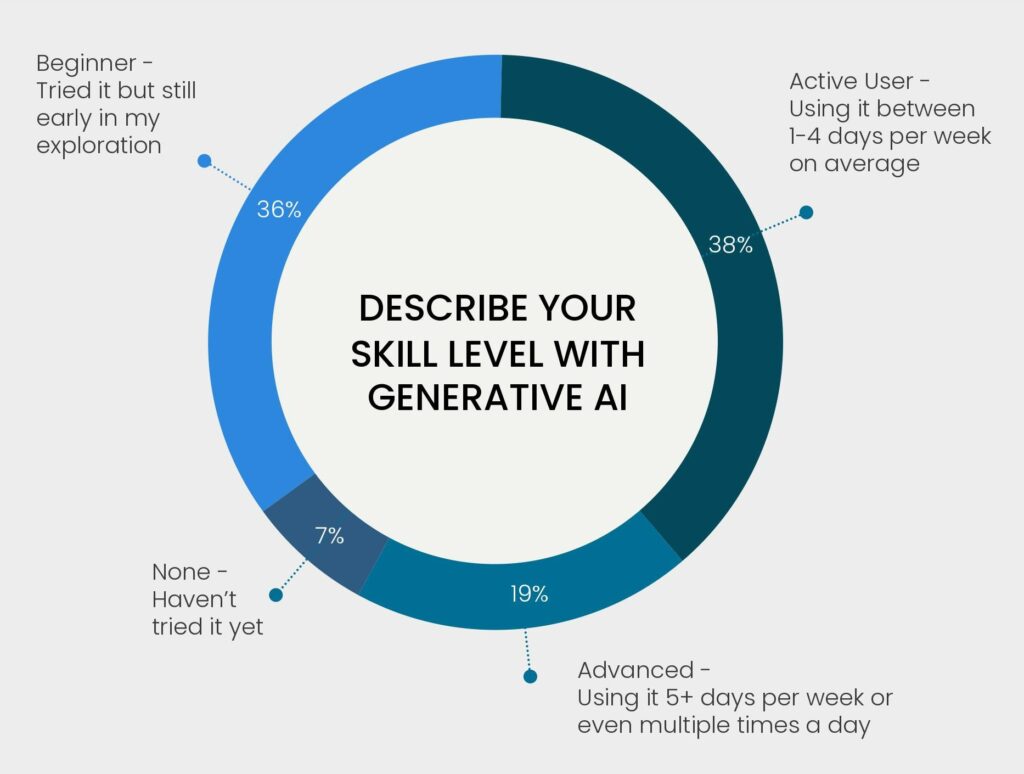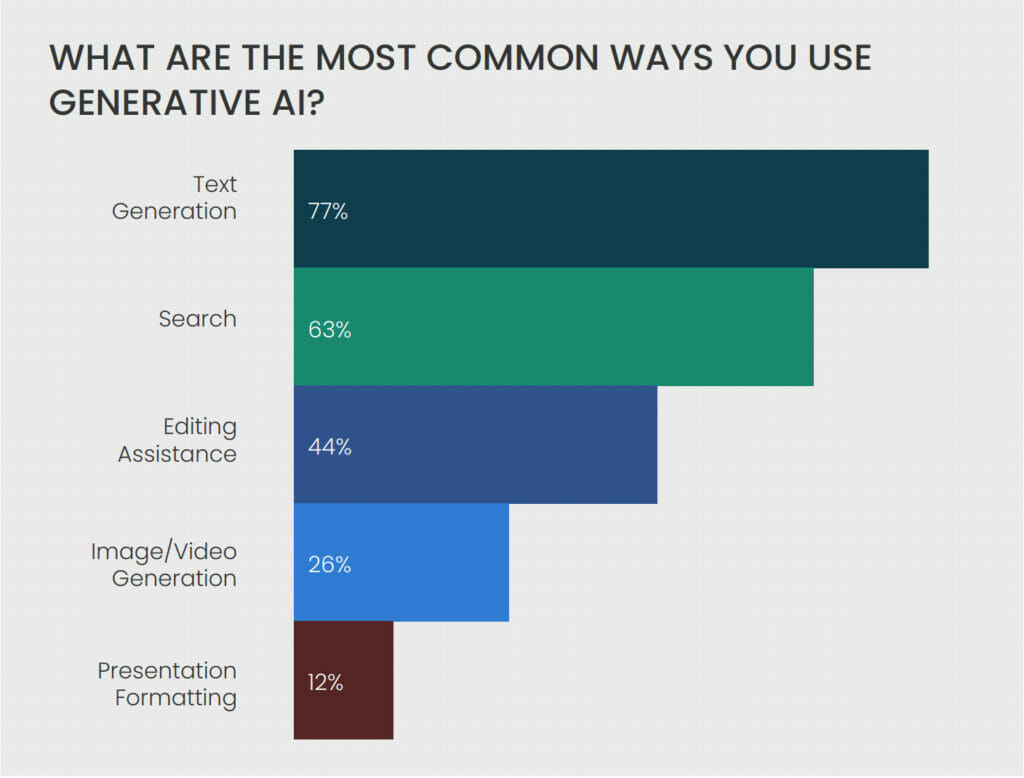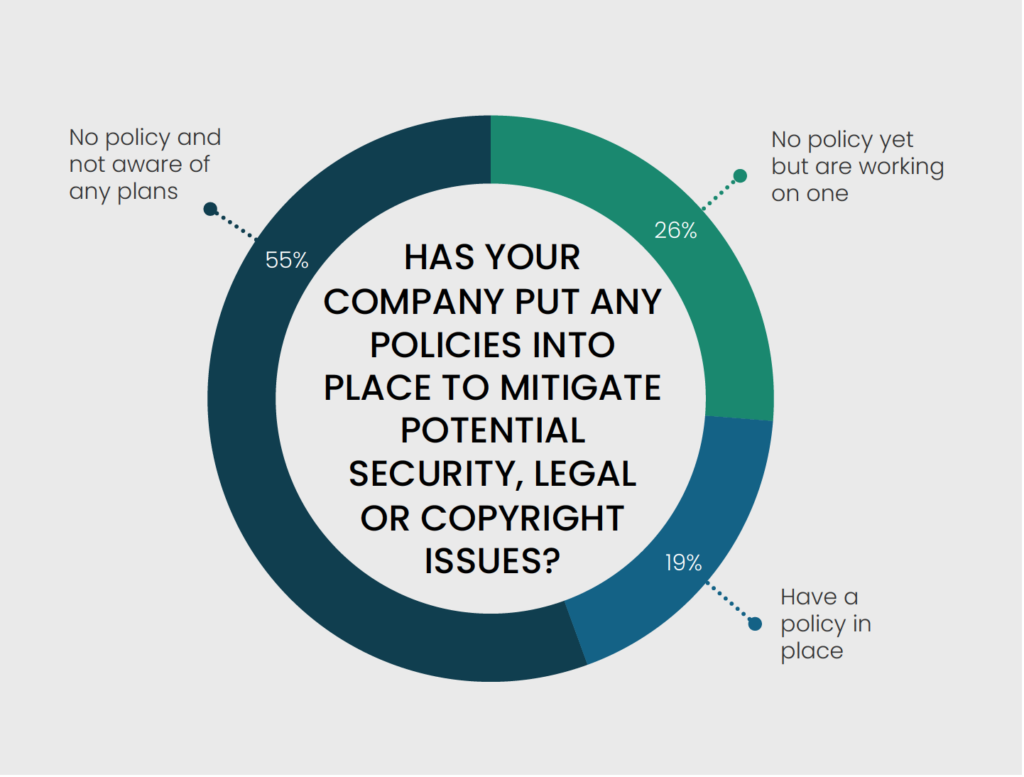The race for marketers to adopt generative AI is on — and so far, they’re optimistic about it.
In May 2023, we fielded an online survey, Generative AI in Marketing, to find out how marketers view the benefits, challenges, and potential of generative AI. The goal was to understand how leaders are currently using this technology and to share those findings with marketers so they can ground themselves in the latest thinking and best practices of their peers.
Despite headlines that AI could replace jobs, the survey respondents overwhelmingly rejected the idea that marketing teams will be reduced by generative AI. In fact, they see the technology as a tool for productivity and creativity. I was heartened to see that reaction — and surprised at a few of the other findings. Let’s walk through the takeaways.
Marketers Are Embracing Generative AI, Dispelling Concerns Over Reducing Team Size

A whopping 93 percent of marketers are already using generative AI. Only a few (7 percent) reported having not used a single gen AI tool. Over half consider themselves active or advanced users, and nearly one in five report using gen AI tools five days a week or more. This is remarkable given the short time frame that most marketers would have adopted gen AI into their processes. And for the marketers who haven’t used gen AI, most cited it’s because “hadn’t gotten around to it yet.”
ChatGPT is the most popular, but marketers aren’t ready to commit to just one tool. ChatGPT’s free and paid versions are currently the most-used tools, but half of all respondents who use gen AI report using multiple tools, including Jasper, Bard and Writer. Maybe it’s early exploration to understand the strengths and weaknesses of each platform, or it’s a glimpse into the future of our tech stacks. Time will tell.
Generative AI is a value-add — not a threat. Despite understandable concern that gen AI could replace workers, 81 percent of marketing leaders say gen AI won’t reduce team size. Nearly one in five respondents expect to hire more people to take advantage of gen AI capabilities. This is particularly interesting when you consider that 62 percent of respondents are senior marketing decision makers (directors, VPs, CMOs, and CGOs) with hiring authority.
The data suggests marketers understand that gen AI is a tool to help them work more efficiently and effectively, rather than a replacement for human creativity and critical thinking. One respondent said, “I view generative AI as an intern. Provide it with detailed instructions. Let it work. Then review and edit everything to ensure it is accurate, professional, plagiarism-free, and on-brand.”
“I view generative AI as an intern. Let it work. Then review and edit everything to ensure it is accurate, professional, plagiarism-free, and on-brand.”
As such, gen AI is likely to be embraced as a valuable asset to marketing teams rather than a threat to job security. As my Norwest colleague Rama Sekhar put it in a recent interview “AI isn’t coming for your job. Someone using AI is coming for your job.”
Download the full survey ›
Goodbye, Writer’s Block. Hello, AI-Generated Content.
Marketers primarily use generative AI for text generation, search and editing. A large majority (77 percent) of respondents said they use the technology to generate text or content in their jobs, followed closely by search (63 percent). One respondent even called gen AI the “best search engine” they’ve ever used. While the results often help users get over writer’s block, we urge caution with blindly accepting the outputs.
My friend Barak Turovsky, who led AI efforts at Google for a decade, created a helpful framework for evaluating potential use cases. He assesses two dimensions: fluency and accuracy. He cautions that fluency often mimics confidence — similar to charismatic people who can convincingly talk about any topic, we may get carried away by their demeanor and believe what they say, whether it’s true or not. In an April 2023 sitdown with Norwest marketing leaders and Barak, we discussed the importance of fact-checking with reliable resources. We also encouraged folks to draw a distinction between real-time web search and querying against a gen AI tool’s dated training data.

Marketers are slower to adopt generative AI for images or videos. Only about seven percent of marketers report use of Stable Diffusion for text-to-image generation. It’s not surprising to see fewer marketers using gen AI to create images or videos. Image and video content require large amounts of data to train AI models effectively, making it more challenging to produce reliable results. Legal risks may be another barrier to adoption of the image generation use case. Litigation around gen AI is rapidly evolving, particularly around the implications for copyright and intellectual property infringement.
Nonetheless, as new tools emerge and the technology advances, there is a huge opportunity for marketers to tap into capabilities for image and video creation, along with presentation design. Google Bard already announced a partnership with Adobe Firefly to bring image generation to the once text-only tool. There’s little doubt we’ll see more partnerships like this in the future.
Nearly half of marketers believe generative AI has the power to supercharge content creation. They recognize the potential of generative AI in transforming content creation processes across marketing functions. For example, a white paper – which could take weeks to research and write – can be generated in minutes. (Of course, we must also budget editing time into this equation!) The same goes for blog posts, emails, social media posts and other content.
Marketers also see how the technology could augment demand generation and product marketing, particularly with messaging frameworks and customer profile development. A recent McKinsey reports details the opportunities for teams to hyper-personalize content throughout the customer journey using gen AI.
Most marketers believe generative AI will positively impact their brands. Two out of three respondents think the technology will free up time for creativity, whereas less than 8 percent fear losing uniqueness in their marketing messaging. And while we’ve only just begun to see how gen AI will transform brands and teams, the value marketers see in leveraging all that gen AI has to offer is a promising sign of what the future may hold.
Generative AI Helps Marketers Save Time
Sixty percent of marketers estimate generative AI has saved them time. When asked to estimate how much time they’ve saved by using gen AI tools, most respondents said the technology had improved their output by at least 25 percent. One respondent said gen AI’s “power of summarizing” was the real time saver. “From a marketing messaging guide in PDF, I was able to create a table with a script for a series of 8x 60-second social videos and accompanying posts for LinkedIn. All in a single prompt.”
Prompt experimentation and editing outputs are barriers to time savings. Nearly a quarter of marketers (24 percent) report no time savings or that they spend even more time than they would normally. They tell us they need the additional time to edit responses into something usable — or, they get caught up in experimenting with different prompts. This could suggest that training is necessary to help teams use these tools to their full potential and to understand the specific use cases where gen AI is most helpful. It’s also a good reminder that gen AI is not a magic solution for all use cases, and human input is often necessary to achieve the desired results. But anything is better than staring at a blank screen and I like how gen AI opens my mind to ideas and angles that I would not have otherwise considered.
“Anything is better than staring at a blank screen. I like how gen AI opens my mind to ideas and angles that I would not have otherwise considered.”
Pro tip: Use prompt marketplaces, such as PromptBase, PromptHero, ChatX, AIPRM and FlowGPT, to produce better results.
The 5 Biggest Risks for Marketers Using Generative AI
Interestingly, the survey results mirror the concerns we’ve heard from the marketing leaders in the Norwest portfolio. How do I know my data is safe? What might be considered plagiarism? How can I make it sound like my brand?
Our survey found the top five concerns for marketers regarding gen AI are:
- Accuracy (55 percent)
- Quality control (44 percent)
- Data privacy (31 percent)
- Legal and copyright issues (30 percent)
- Plagiarism (29 percent)
One thing’s clear: generative AI policy is lagging adoption. According to our survey, fewer than 20 percent of marketing leaders have a policy in place to mitigate potential security, legal or copyright issues with generative AI. However, about 26 percent are currently creating such policies. Perhaps that is why marketers are more concerned about accuracy and quality control than being replaced by AI.
The Dos and Don’ts of Using Generative AI, According to Early Adopters
In the same sit down with Norwest marketing leaders and Barak Turovsky that I mentioned earlier, we discussed best practices and solutions to some of these concerns:
The Dos of Gen AI in Marketing |
The Don’ts of Gen AI in Marketing |
|---|---|
|
|
|
|
|
|
|
|
Have a “human in the loop” system. Generative AI hallucinations are real. Keep in mind that gen AI is trained to give you an answer, whether it’s right or wrong. There is no substantive understanding beneath the thin layer of words, so occasionally AI can state something as fact without any supporting reality — what’s called an AI hallucination. Even though ChatGPT is getting better and better at listening and synthesizing multiple sources of content, it’s less optimized to process contradictory content and provide both sides. It may decide to spit out one viewpoint and that decision could be wrong, which is why human involvement and review is so critical.
Train the model with existing content. As for making your AI-generated outputs “sound” like you or your brand, we recommend feeding the model your existing content, then asking it to extract your voice and tone. You can also use a good source of internal data to train the model. For example, some companies have used AI to analyze historical consumer behavior data to predict the likelihood of a customer responding favorably to a marketing campaign.
Combine generative AI with other tools. To make gen AI more powerful for your marketing organization, try combining it with tools that analyze performance. Say you’re sending hundreds of AI-generated emails that are all different from one another — adding a plugin or API that can A/B test will help you understand what converts better, so you can replicate that in the future. New plugins and integrations are released daily it seems, including on Zapier and ChatGPT Marketplace, which are more robust than others I’ve seen. If you’re interested in joining a community of other AI enthusiasts in marketing, we found this Slack community to be helpful.
Keep experimenting with prompts. It’s only a matter of time before gen AI finds its way into all our workflows — and even personal lives. In February, I tried to use ChatGPT to write valentines cards for my friends and family… and it didn’t quite produce the results I was looking for. (Alas, I was forced to drum up my own words of affirmation!). Another reason to continue experimenting with different use cases.
Have more thought starters or questions about gen AI in marketing? Feel free to reach out and let me know what’s on your mind.
Download the full survey ›
About the Survey
The Norwest Quick Pulse Survey: Generative AI in Marketing was conducted online between April 28 and May 5, 2023. The survey solicited opinions and beliefs about the role of generative AI in marketing from 257 self-described marketing professionals.




